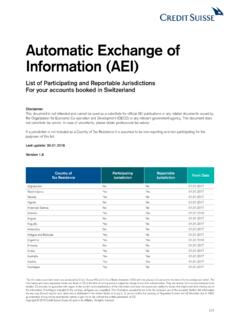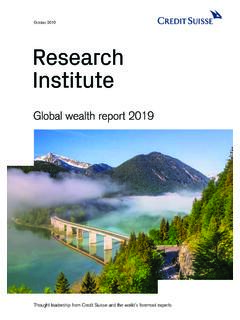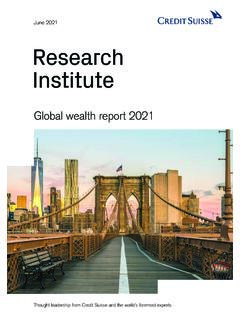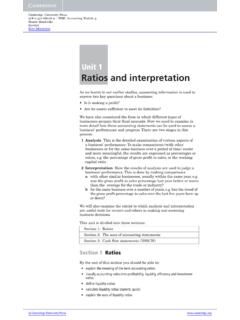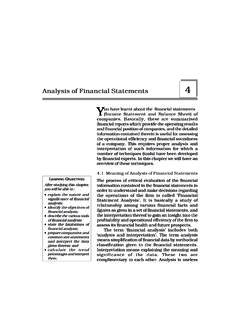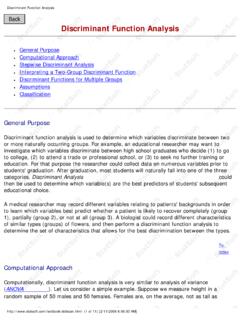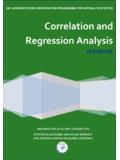Transcription of Technical Analysis - Explained - Credit Suisse
1 Patterns(Elliott waves)Trend(Moving averages)Momentum(Rates-of-change)Techni cal Analysis - ExplainedPrivate BankingZurich/SwitzerlandGlobal Technical Research and Behavioral FinanceCautionHopeGreedOptimismEuphoriaC onvictionConfidenceReliefDespondencyPess imismFearPanicDenial- 2 - Technical Analysis - ExplainedGlobal Technical Research60006500700075008000850090009500 ContentsWhat is Technical Analysis ? ..3 Technical Analysis pre-empts fundamental data ..4 Mood governs ratio ..5 Optimism, pessimism, greed and fear ..6 Chart types and chart construction ..7 Support and resistance ..8 Trendlines ..9 Investment horizons ..10 What trend?
2 11 Moving averages ..12 The simple moving average ..13 Long-, medium- and short-term averages ..14 Moving average crossover ..15 Momentum ..16 Momentum, indicator signals ..17 Long-, medium- and short-term indicators ..18 Trend and momentum combination ..19 Reversal and redistribution ..20 Equity Analysis ..21 Cycle phase distribution ..22 The Elliott Wave Principle ..23 Catalog of impulsive waves ..24 Catalog of corrective patterns ..25 Impulsive wave patterns, example..26 Corrective wave patterns, example ..27 Head and shoulder reversal pattern ..28 Fascinating Fibonacci ..29 Wave correlations ..30 Fibonacci correlation - more than coincidence.
3 31 Diploma in basic Technical Analysis ..32- 3 - Technical Analysis - ExplainedGlobal Technical ResearchWhat is Technical Analysis ? Technical Analysis is the study of financial market action. The technician looks at price changes thatoccur on a day-to-day or week-to-week basis or over any other constant time period displayed ingraphic form, called charts. Hence the name chart chartist analyzes price charts only, while the Technical analyst studies Technical indicators derivedfrom price changes in addition to the price analysts examine theprice actionof the financial marketsinsteadof thefundamentalfac-tors that (seem to) effect market prices.
4 Technicians believe that even if all relevant information of aparticular market or stock was available, you still could not predict a precise market "response" to thatinformation. There are so many factors interacting at any one time that it is easy for important onesto be ignored in favor of those that are considered as the "flavor of the day."The Technical analyst believes that all the relevant market information is reflected (or discounted) inthe price with the exception of shocking news such as natural distasters or acts of God. These fac-tors, however, are discounted very financial markets, it becomes obvious that there are trends , momentum and patterns thatrepeat over time, not exactly the same way but similar.
5 Charts are self-similar as they show the samefractal structure (a fractal is a tiny pattern; self-similar means the overall pattern is made up of smallerversions of the same pattern) whether in stocks, commodities, currencies, bonds. A chart is a mirrorof themood of the crowdand not of the fundamental , Technical Analysis is theanalysis of human mass , it is also called behavioral chartTechnical indicators- 4 - Technical Analysis - ExplainedGlobal Technical ResearchTechnical Analysis pre-empts fundamental dataFundamentalists believe there is acause and effectbetweenfundamentalfactors andprice means, if the fundamental news is positive the price should rise, and if the news is negative theprice should fall.
6 However, long-term analyses of price changes in financial markets around the worldshow that such a correlation is present only in the short-term horizon and only to a limited extent. It isnon-existent on a medium- and long-term fact, the contrary is true. The stock market itself is the best predictor of the future fundamentaltrend. Most often, prices start rising in a new bull trend while the economy is still in recession (positionB on chart shown above), while there is no cause for such an uptrend. Vice versa, prices startfalling in a new bear trend while the economy is still growing (position A), and not providing fundamen-tal reasons to sell.
7 There is a time-lag of several months by which the fundamental trendfollowsthestock market trend. Moreover, this is not only true for the stock market and the economy, but also forthe price trends of individual equities and company earnings. Stock prices peak ahead of peak earn-ings while bottoming ahead of peak purpose of Technical Analysis is to identify trend changes that precede the fundamentaltrend and do not (yet) make sense if compared to the concurrent fundamental growthStock marketBBA- 5 - Technical Analysis - ExplainedGlobal Technical ResearchMood governs ratioKnow yourself and knowledge of the stock market will soon follow.
8 Ego and emotions determine farmore of investors stock market decisions than most would be willing to years, we have dealt with professional money managers and committees and found they were asmuch subject to crowd following and other irrational emotional mistakes as any novice investor. Theywere, for the most part, better informed, but facts alone are not enough to make profitable deci-sions. The human element, which en-compasses a range of emotions fromfear to greed, plays a much bigger rolein the decision-making process thanmost investors a practical sense, most investors actexactly opposite to the rational wisdomof buying low and selling high based onvery predictable emotional responses torising or falling prices.
9 Falling prices thatat first appear to be bargains generate fear of loss at much lower prices when opportunities are thegreatest. Rising prices that at first appear to be good opportunities to sell ultimately lead to greed-induced buying at much higher levels. Reason is replaced by emotion and rationalization with suchcyclical regularity, that those who recognize the symptoms and the trend changes on the charts canprofit very well from this who manage to act opposite to the mood of the crowd and against their own emotions arebest positioned to earn money in the financial risk and emotional risk 6 - Technical Analysis - ExplainedGlobal Technical ResearchOptimism, pessimism, greed and fearWhy aren t more people making more money in the financial markets?
10 Because, as we have seen,people are motivated by greed (optimism) when buying and by fear (pessimism) when selling. Peopleare motivated to buy and sell by changes in emotion from optimism to pessimism and vice formulate fundamental scenarios based on their emotional state (a rationalization of the emo-tions), which prevents them from realizing that the main drive is chart above shows that if investors buy based on confidence or conviction (optimism) they BUYnear or at the TOP. Likewise, if investors act on concern or capitulation (pessimism) they SELL nearor at the BOTTOM. Investors remain under the bullish impression of the recent uptrend beyond theforming price top and during a large part of the bear trend.

